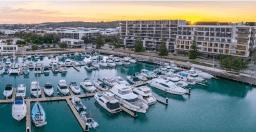Building quality homes
Sustainability is no longer a nice-to-have, nor is it something that residents should have to opt into. In today’s world, delivering quality homes is synonymous with delivering sustainable homes.
Words: Rory Martin, Sustainability Manager, Frasers Property Australia.
About two years ago I was sitting in a focus group with some of our customers discussing technologies like geothermal and solar, as well as other energy saving features like window glazing and orientation. We were discussing these things in the context of saving money and being good for the environment when one of the participants said something that really transformed the way I viewed sustainability up until that point. He said, “All this stuff… This is just what we expect in a good quality home now.”
Talk about your light-bulb moment. Sustainability is no longer a nice-to-have, nor is it something that residents should have to opt into. In today’s world, delivering quality homes is synonymous with delivering sustainable homes. Knowing this, the question then became, how can we do more? It’s never been our M.O. to do the bare minimum. Being a world leading developer with more than 95 years of experience in the Australian market comes with an obligation to contribute to the industry’s constant evolution and improvement.
Our Fairwater community in Blacktown was the first community in New South Wales to achieve a 6-Star Green Star Communities rating from the Green Building Council in Australia and is home to the largest residential installation of geothermal heating and cooling in the southern hemisphere. Similar geothermal installations are now on the cards for upcoming developments including Ed.Square in Sydney’s south-west and Burwood Brickworks in Victoria.
An active interest in passive design
Perhaps the most experimental project we’ve ever undertaken is currently underway in Melbourne’s Point Cook. We’re building what’s known as a Passive House. Back in the 70’s, a global energy crisis profoundly rocked western economies with skyrocketing fuel and heating costs. American builders, looking to uncouple their fate from volatile oil prices, grappled with the challenge of building homes that used little or no energy to heat. They hit upon a standard that captured passive heat from the sun during winter, eliminated air leakage, and insulated the home to a greater standard than had previously been seen. The result? Homes that could maintain a comfortable temperature range of 20-25 degrees all year round without much – or any - intervention.
Here in Australia there are several really interesting boutique Passive House projects underway or recently completed. Many are highly individualised private residences with unique architectural character and footprints. These homes are gorgeous examples of the passive design, but not terribly accessible to the masses. That got us thinking – what if we, a major developer with broad market reach and influence, could deliver passive home options into the national residential market? And so, the Point Cook Passive House project was born: an experiment in mass-market housing design.
Like all good science experiments this one has a test subject and a control subject. Two seemingly identical homes built side-by-side on our Life, Point Cook development. Both homes have the same orientation and the same passive solar access. But beneath their identical exteriors will beat two very different hearts. Our control house will be built per normal non-Passive House methods. Our test house will be a Passive House. Once complete, two families will move in and take part in a 12-month trial where we’ll gather data on energy consumption, comfort levels, building performance and so on.
What we hope to show is that even with the added cost of building to Passive House certification, the long-term energy savings combined with improvements in home performance, comfort, and wellbeing will make Passive House design something the volume construction sector will want to embrace.
The future is green
Wherever the future of sustainable home design takes us, we know that its role is to future-proof the liveability of our communities and improve the health and wellbeing of the people that will live there for generations to come. This means we’ll no longer think of sustainability as the exception, but as the rule. I’m excited to be part of that journey.
New edition out now - Live Proud Spring/Summer 2019. This latest edition tells the story of our 95 year history of creating communities in Australia, as well as many more customer stories. We hope you enjoy the read.
Read the Live Proud magazine here


